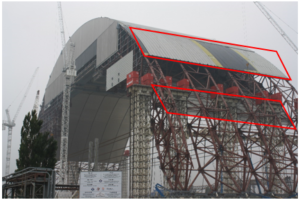Chernobyl NSC: A Test of Time
Public engagement 16th February 2017
The nuclear accident at Chernobyl Nuclear Power Plant has been discussed previously on Hitchhiker, with features mainly focusing on the immediate history of the disaster. Today, the Chernobyl site remains a concern within the nuclear industry, and the containment of radioactive material is crucial when considering environmental and social impact. The Chernobyl New Safe Confinement (NFC) is designed to operate over 100 years, resist seismic impact (of up to 6-point magnitude) and boasts impressive functions to prevent leakage of material. It will also serve as a means to deconstruct the original sarcophagus, which was hurriedly built over the damaged reactor building as an emergency measure. The new shelter was designed to ‘slide’ over the affected building and contain it for 100 years. Job done, right?

Well, it’s just too early to say. Nothing of this size (162 m width, 109 m height) and weight (36,470 t, or ~2,900 London buses) has ever been made mobile; nor has there been such a leak-tight containment shelter built for a radioactive disaster site. However, the technology does, on paper, look promising. Between internal and external claddings, a ventilation system will maintain a permanent pressure, preventing escape of radioactive substances. An active corrosion-control system will also be used to extend the lifetime of the structure, preventing damage from moisture, radiation and heat exposure through ventilation and humidity control systems. An elastic membrane will connect the arch with the existing structures, minimising leaks and impacts between the two structures.1 It sounds like the perfect solution, but what can’t be stressed enough, is the unique nature of the conditions and circumstances that this project will be under. In practice, the success of the NSC can only be tested with time, but if the next stages of the project have been planned with the same degree of critical thinking as that shown during implementation it will be a great step forward in overcoming the Chernobyl legacy.
- Ebrd.com, 2017


